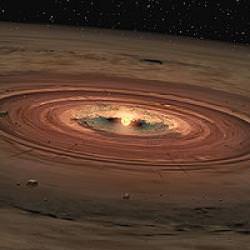Organic molecules are thought by scientists to be instrumental in kickstarting life as we know it on Earth. Within our Solar System they can be found in comets, and they cause the redness of the clouds of Saturn’s moon Titan. New observations of a planet-forming disk around a star 220 light-years from Earth reveal for the first time that these molecules exist elsewhere in the Universe.
Astronomers at the Carnegie Institute have detected the presence of organic molecules in the dusty disk surrounding HR 4796A, an eight-million year-old star in the constellation Centaurus. Using Hubble’s Near-Infrared Multi-Object Spectrometer they analyzed the light coming from the disk and found that its red color is due to large organic carbon molecules called tholins. The analysis ruled out other causes of the red light, such as iron oxide.
“Until recently it’s been hard to know what makes up the dust in a disk from scattered light, so to find tholins this way represents a great leap in our understanding,â€? said John Debes of the Carnegie Institute’s Department of Terrestrial Magnetism, one of the authors of the study.
Just as in our early Solar System, the disk of dust is in the process of forming planets. The collision of small bodies like asteroids and comets creates the dust in the disk, and the organic molecules present on these objects could then be scattered on any planets orbiting the star. This discovery makes it clear that it is possible for organic molecules to exist in the early stages of planet formation, paving the way for the possible development of life later on.
Organic molecules are thought to be essential to the development biological organisms because they are made up of carbon, the building block of life on Earth. The discovery of these molecules elsewhere in the Universe does not mean that life exists there yet – or even that it will in the future – but it does increase the tantalizing prospect of life forming outside our Solar System.
The study was published in the current Astrophysical Journal Letters by John Debes and Alycia Weinberger of the Carnegie Institution’s Department of Terrestrial Magnetism with Glenn Schneider of the University of Arizona.
Source: Carnegie Institute Press Release


I think organic molecules in interstellar space have been known for some time (try googling interstellar organic): what’s new is their detection in a circumstellar disc, according to the press release you linked.
This is old news. Organic compounds in space have been known and appreciated for at least 40-50 years. This is an old and wonderful story. Where have you been?????
To the last poster, notice the headline “outside our Solar System”. That is the significant part.
I consider it as a very interesting and important subject, and appreciate the article. Given what is going on in my country (�a model Triceratops is shown wearing a saddle� http://en.wikipedia.org/wiki/Creation_Museum) the important discoveries of the sort should be repeatedly reported.
Another point relates to tholins: The PAH world hypothesis was proposed recently – in 2005, and �2007 Cassini spacecraft found the presence of heavy negative ions of tholin in the upper regions of Titan�s atmosphere� http://en.wikipedia.org/wiki/PAH_world_hypothesis
Surfing the links, (http://en.wikipedia.org/wiki/Tholin
http://www.daviddarling.info/encyclopedia/T/tholin.html)
one can find that Kerogens are complex, for example: C215H330O12N5S. http://en.wikipedia.org/wiki/Kerogen. �Carbonaceous chondrite meteorites contain kerogen-like components. Such material is believed to have formed the terrestrial planets. Kerogen materials have been detected in interstellar clouds and dust around stars.�
More links:
Life On Earth May Have Originated As The Organic Filling In A Multilayer Sandwich Of Mica Sheets http://www.sciencedaily.com/releases/2007/12/071204102500.htm and http://www.npr.org/templates/story/story.php?storyId=17007216
How Did Life Begin? Biochemical Evolution On Mineral Surfaces http://www.sciencedaily.com/releases/1998/04/980402074305.htm
Selecting Life: Scientists Find New Way To Search For Origin Of Life http://www.sciencedaily.com/releases/2006/11/061109130729.htm
Did Life Begin In Space? New Evidence From Comets http://www.sciencedaily.com/releases/2007/08/070814093819.htm
�why scientists should look beyond organic matter in their search for the origins of life… http://www.usatoday.com/tech/science/space/2007-08-30-comet-life-origins_N.htm
Old news nothing really new but the thiolins. The stuff of life is everywhere in our galaxy. The only surpriing thing is that this collection of molecles is aware of it !
Hay Gary, get with the programme – we found organic molecules OUTSIDE the solar system 50 years AGO !!!!!
oranic molecules + some of that dna floating around = stuff like us : )
Hi,
I seem to remember reports of amino acids discovered in molecular clouds 20 or more years ago.
Can anyone confirm this?